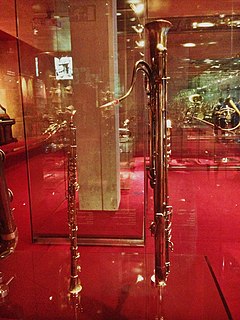The contrabassophone is a woodwind instrument, invented about 1847 by German bassoon maker Heinrich Joseph Haseneier. [1] It was intended as a substitute for the contrabassoon, which at that time was an unsatisfactory instrument, with a muffled sound due to tone holes that were too small and too close together. Haseneier's design made use of some of the same principles that went into the Boehm system flute, in which keywork was developed based on tone holes with acoustically optimum sizes and positions. The contrabassophone's bore was substantially larger (by about a third) than that of the contrabassoon, and the result was an instrument with a powerful tone. Indeed, it was regarded as too loud for orchestral use, though it was suitable for outdoor use in military bands. [2] Dr W.H. Stone brought a Haseneier instrument to England playing it in performances of the Handel Festival of 1871. Alfred Morton, the best English bassoon maker of the time made 3 or 4 copies of this instrument some of which included improvements in the keywork. In 1881, Morton's eldest son played one of these instrument with the Halle Orchestra. He also played it at the Crystal Palace, at Richter's concerts and at the opera. Morton made one of a higher pitch (in F) for Sir Arthur Sullivan for use in the Savoy Theatre. Following Sullivan's death, this instrument disappeared. Many other European makers produced copies of the contrabassophone, including a lightweight version made of papier-mâché. [1]

Woodwind instruments are a family of musical instruments within the more general category of wind instruments. There are two main types of woodwind instruments: flutes and reed instruments. What differentiates these instruments from other wind instruments is the way in which they produce their sound. All woodwinds produce sound by splitting an exhaled air stream on a sharp edge, such as a reed or a fipple. A woodwind may be made of any material, not just wood. Common examples include brass, silver, cane, as well as other metals such as gold and platinum. Occasionally woodwinds are made out of earthen materials, especially ocarinas. Common examples include flute, oboe, clarinet, bassoon, and saxophone.

Germany, officially the Federal Republic of Germany, is a country in Central and Western Europe, lying between the Baltic and North Seas to the north, and the Alps to the south. It borders Denmark to the north, Poland and the Czech Republic to the east, Austria and Switzerland to the south, France to the southwest, and Luxembourg, Belgium and the Netherlands to the west.

The bassoon is a woodwind instrument in the double reed family that plays music written in the bass and tenor clefs, and occasionally the treble. Appearing in its modern form in the 19th century, the bassoon figures prominently in orchestral, concert band, and chamber music literature. It is known for its distinctive tone colour, wide range, variety of character, and agility. One who plays the bassoon is called a bassoonist.
Adolphe Fontaine-Besson patented a similar instrument in 1890 but allowed the patent to lapse in 1898. [2] By this time the contrabassophone had been largely superseded by improved versions of the contrabassoon for orchestral use, and by the tuba in wind bands.
Besson is a manufacturer of brass musical instruments. It is owned by Buffet Crampon, which bought Besson in 2006 from The Music Group.

The tuba (bass) is the largest and lowest-pitched musical instrument in the brass family. As with all brass instruments, the sound is produced by lip vibration into a large mouthpiece. It first appeared in the mid-19th century, making it one of the newer instruments in the modern orchestra and concert band. The tuba largely replaced the ophicleide. Tuba is Latin for 'trumpet'.
An instrument like those that Morton made has a range of three octaves and one tone from a low C to a high D. The fingerings are like a recorder to some degree, with a number of chromatic notes played with forked fingerings, making it quite difficult to play in keys with three or more accidentals. This could have been one of the reasons that the instrument was not played in English orchestras by the late part of the nineteenth century, instead being played in military bands such as the Coldstream, the Grenadier and the Scots Guards.

The Band of the Coldstream Guards is one of the oldest and best known bands in the British Army, having been officially formed on 16 May 1785 under the command of Major C F Eley, reflecting the fact that the Coldstream Guards regiment is the second oldest of the guards regiments. Although the band is not technically the oldest in the Army, it has the longest standing tradition of music, as from its earliest days the officers of the Coldstream Guards hired eight musicians to provide music for the regiment during the changing of the guard. This is an event which still occurs today, every other day at eleven thirty in the summer outside Buckingham Palace.

The Band of the Grenadier Guards is the oldest of all of the bands in the British Army, with a history dating back over 333 years.

The Band of the Scots Guards is one of five bands in the Foot Guards Regiments in the Household Division which primarily guards the British monarch.

The clarinet is a musical-instrument family belonging to the group known as the woodwind instruments. It has a single-reed mouthpiece, a straight, cylindrical tube with an almost cylindrical bore, and a flared bell. A person who plays a clarinet is called a clarinetist.

Oboes belong to the classification of double reed woodwind instruments. Oboes are usually made of wood, but there are also oboes made of synthetic materials. The most common oboe plays in the treble or soprano range. A soprano oboe measures roughly 65 cm long, with metal keys, a conical bore and a flared bell. Sound is produced by blowing into the reed at a sufficient air pressure, causing it to vibrate with the air column. The distinctive tone is versatile and has been described as "bright". When the word oboe is used alone, it is generally taken to mean the treble instrument rather than other instruments of the family, such as the bass oboe, the cor anglais, or oboe d'amore

The saxophone is a family of woodwind instruments. Saxophones are usually made of brass and played with a single-reed mouthpiece similar to that of the clarinet. When the player presses a key, a pad either covers a hole or lifts off a hole, lowering or raising the pitch, respectively.
The Boehm system is a system of keywork for the flute, created by inventor and flautist Theobald Boehm between 1831 and 1847.

The sarrusophones are a family of transposing woodwind musical instruments patented and placed into production by Pierre-Louis Gautrot in 1856. Originally designed as double-reed instruments, single-reed mouthpieces were later developed, at least for some of the larger sizes. It was named after the French bandmaster Pierre-Auguste Sarrus (1813–1876) who is credited with the concept of the instrument, though it is not clear whether Sarrus benefited financially from this association. The instrument was intended to serve as a replacement in wind bands for the oboe and bassoon which, at that time, lacked the carrying power required for outdoor band music.

The contrabassoon, also known as the double bassoon, is a larger version of the bassoon, sounding an octave lower. Its technique is similar to its smaller cousin, with a few notable differences.

The bass clarinet is a musical instrument of the clarinet family. Like the more common soprano B♭ clarinet, it is usually pitched in B♭, but it plays notes an octave below the soprano B♭ clarinet. Bass clarinets in other keys, notably C and A, also exist, but are very rare. Bass clarinets regularly perform in orchestras, wind ensembles/concert bands, occasionally in marching bands, and play an occasional solo role in contemporary music and jazz in particular.
Contrabass refers to a musical instrument of very low pitch—generally one octave below bass register instruments. While the term most commonly refers to the double bass, many other instruments in the contrabass register exist.

The serpent is a bass wind instrument, descended from the cornett, and a distant ancestor of the tuba, with a mouthpiece like a brass instrument but side holes like a woodwind. It is usually a long cone bent into a snakelike shape, hence the name. The serpent is closely related to the cornett, although it is not part of the cornett family, due to the absence of a thumb hole. It is generally made out of wood, with walnut being a particularly popular choice. The outside is covered with dark brown or black leather. Despite wooden construction and the fact that it has fingerholes rather than valves, it is usually classed as a brass; the Hornbostel-Sachs scheme of musical instrument classification places it alongside trumpets.
The alto clarinet is a woodwind instrument of the clarinet family. It is a transposing instrument pitched in the key of E♭, though instruments in F have been made. In Europe it is sometimes called a tenor clarinet. In size it lies between the soprano clarinet and the bass clarinet, to which it bears a greater resemblance in that it typically has a straight body, but a curved neck and bell made of metal. All-metal alto clarinets also exist. In appearance it strongly resembles the basset horn, but usually differs in three respects: it is pitched a tone lower, it lacks an extended lower range, and it has a wider bore than many basset horns.

The contrabass saxophone is the second-lowest-pitched extant member of the saxophone family proper. It is extremely large and heavy, and is pitched in the key of E♭, one octave below the baritone saxophone.

The ophicleide is a keyed brass instrument similar to the tuba. It is a conical-bore keyed instrument belonging to the bugle family and has a similar shape to the sudrophone.
In music, fingering, or on stringed instruments stopping, is the choice of which fingers and hand positions to use when playing certain musical instruments. Fingering typically changes throughout a piece; the challenge of choosing good fingering for a piece is to make the hand movements as comfortable as possible without changing hand position too often. A fingering can be the result of the working process of the composer, who puts it into the manuscript, an editor, who adds it into the printed score, or the performer, who puts his or her own fingering in the score or in performance.
The tenor bassoon or tenoroon is a member of the bassoon family of double reed woodwind instruments. This group also includes the more widely known bassoon and contrabassoon, along with a smaller version of the tenor bassoon, the octave bassoon.

The Boehm system for the clarinet is a system of clarinet keywork, developed between 1839 and 1843 by Hyacinthe Klosé and Auguste Buffet jeune. The name is somewhat deceptive; the system was inspired by Theobald Boehm's system for the flute, but necessarily differs from it, since the clarinet overblows at the twelfth rather than the flute's octave. Boehm himself was not involved in its development.
The contraforte is a proprietary instrument with a range similar to the contrabassoon produced by Benedikt Eppelsheim and Guntram Wolf. It is intended to have improved dynamics and intonation over the distinctive but sometimes reticent sound of the conventional contrabassoon. The contraforte uses a different and wider bore than the contrabassoon to produce a distinct tone; the sound is more even in strength and intonation across registers, remaining quite strong into the high register, unlike a contrabassoon. It also lacks the distinct "rattle" of a contrabassoon, although composers originally may have written contrabassoon parts with that effect in mind, and to this end reeds can be made to provide a more "contrabassoon" sound on a contraforte.
The semi-contrabassoon is a double reed woodwind instrument pitched between the bassoon and the contrabassoon. It is pitched in either F or G a fifth or fourth, respectively, below the bassoon.















